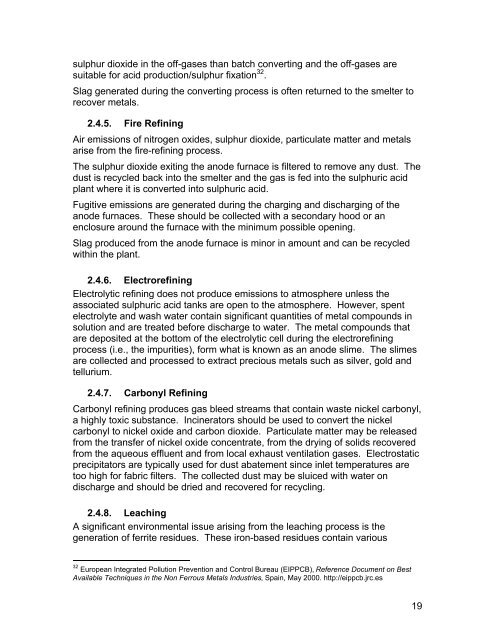(MERAF) for the Base Metals Smelting Sector - CCME
(MERAF) for the Base Metals Smelting Sector - CCME
(MERAF) for the Base Metals Smelting Sector - CCME
You also want an ePaper? Increase the reach of your titles
YUMPU automatically turns print PDFs into web optimized ePapers that Google loves.
sulphur dioxide in <strong>the</strong> off-gases than batch converting and <strong>the</strong> off-gases are<br />
suitable <strong>for</strong> acid production/sulphur fixation 32 .<br />
Slag generated during <strong>the</strong> converting process is often returned to <strong>the</strong> smelter to<br />
recover metals.<br />
2.4.5. Fire Refining<br />
Air emissions of nitrogen oxides, sulphur dioxide, particulate matter and metals<br />
arise from <strong>the</strong> fire-refining process.<br />
The sulphur dioxide exiting <strong>the</strong> anode furnace is filtered to remove any dust. The<br />
dust is recycled back into <strong>the</strong> smelter and <strong>the</strong> gas is fed into <strong>the</strong> sulphuric acid<br />
plant where it is converted into sulphuric acid.<br />
Fugitive emissions are generated during <strong>the</strong> charging and discharging of <strong>the</strong><br />
anode furnaces. These should be collected with a secondary hood or an<br />
enclosure around <strong>the</strong> furnace with <strong>the</strong> minimum possible opening.<br />
Slag produced from <strong>the</strong> anode furnace is minor in amount and can be recycled<br />
within <strong>the</strong> plant.<br />
2.4.6. Electrorefining<br />
Electrolytic refining does not produce emissions to atmosphere unless <strong>the</strong><br />
associated sulphuric acid tanks are open to <strong>the</strong> atmosphere. However, spent<br />
electrolyte and wash water contain significant quantities of metal compounds in<br />
solution and are treated be<strong>for</strong>e discharge to water. The metal compounds that<br />
are deposited at <strong>the</strong> bottom of <strong>the</strong> electrolytic cell during <strong>the</strong> electrorefining<br />
process (i.e., <strong>the</strong> impurities), <strong>for</strong>m what is known as an anode slime. The slimes<br />
are collected and processed to extract precious metals such as silver, gold and<br />
tellurium.<br />
2.4.7. Carbonyl Refining<br />
Carbonyl refining produces gas bleed streams that contain waste nickel carbonyl,<br />
a highly toxic substance. Incinerators should be used to convert <strong>the</strong> nickel<br />
carbonyl to nickel oxide and carbon dioxide. Particulate matter may be released<br />
from <strong>the</strong> transfer of nickel oxide concentrate, from <strong>the</strong> drying of solids recovered<br />
from <strong>the</strong> aqueous effluent and from local exhaust ventilation gases. Electrostatic<br />
precipitators are typically used <strong>for</strong> dust abatement since inlet temperatures are<br />
too high <strong>for</strong> fabric filters. The collected dust may be sluiced with water on<br />
discharge and should be dried and recovered <strong>for</strong> recycling.<br />
2.4.8. Leaching<br />
A significant environmental issue arising from <strong>the</strong> leaching process is <strong>the</strong><br />
generation of ferrite residues. These iron-based residues contain various<br />
32 European Integrated Pollution Prevention and Control Bureau (EIPPCB), Reference Document on Best<br />
Available Techniques in <strong>the</strong> Non Ferrous <strong>Metals</strong> Industries, Spain, May 2000. http://eippcb.jrc.es<br />
19
















